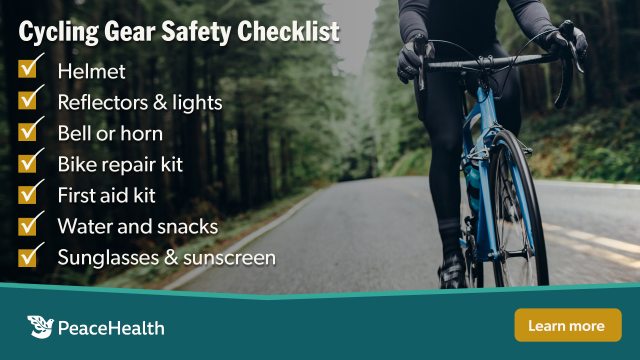Cycling safety checklist
| Safety | Infographics | Healthy You

Key tips to prepare for a safe ride.
Whether you’re a year-round cyclist or only ride when the weather warms up, now is a great time to make sure your bike is good to go when you are.
Before you get on the bike, do a quick safety check to make sure everything is in good shape and still fits. And it doesn't hurt to double-check the tools and supplies you should have ready for any ride— long or short.
“Biking is a great way to get outside with your family,” says Vik Bhagat, MD, pediatrician at PeaceHealth in Ketchikan, Alaska.
Here’s a checklist of things you’ll want to make your ride safe.
- A helmet, of course. But be sure it fits you and that it’s made specifically for bike riding. Often, fire stations or a local hospital will have a helmet check event. They can make sure that your helmet still fits you or your kiddo.
- Reflectors and lights. Typically, this means a white light or reflector at the front of your bike, and a red light or reflector on the back of your bike.
- Bell or horn. This can alert others that you’re near them and give them time to move out of the way if needed.
- Bike repair kit. You may want to include spare tire tubes, a tire pump and something to fix the bike chain.
- First aid kit. This may only be necessary for a longer ride, but it’s nice to have one ready to go when you want it. It could include adhesive bandages, tweezers to remove small rocks or objects, and antiseptic wipes for cleaning a wound.
- Water and snacks. A water bottle or hydration backpack is a good idea to have for any length of bike ride. For snacks, you could pack healthy trail mix, jerky, dried fruit or energy gels.
- Sunglasses and sunscreen. Keeping your eyes and skin protected is important whenever you’re outside. Look for a sweat proof sunscreen that is at least SPF of 30 or higher.
You may also want to pack a wallet, cell phone, rain jacket and straps for pant legs to keep them from getting tangled in wheel or gears.
Other things to keep in mind:
- Ride with traffic, not against it.
- Use bike paths and designated bike routes wherever possible.
- If you're riding alone, let others know where you'll be and when you plan to be back.
- If you plan to stop anywhere, a bike lock can give you peace of mind.
- If there’s no GPS or cell service, consider taking a map of the trail you're planning to be on.
- You might want to take a form of ID and the number for your emergency contact. If you have a medical condition that might cause concerns, consider riding with a buddy.
“Wherever possible, use bike paths and designated bike routes to have the safest, most enjoyable ride. Take advantage of the nice weather and get you and your family outside as much as you can,” says Dr. Bhagat.






